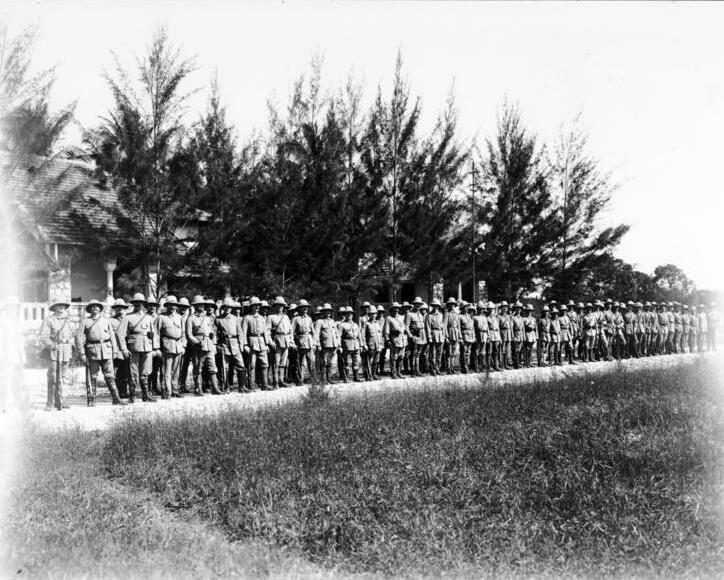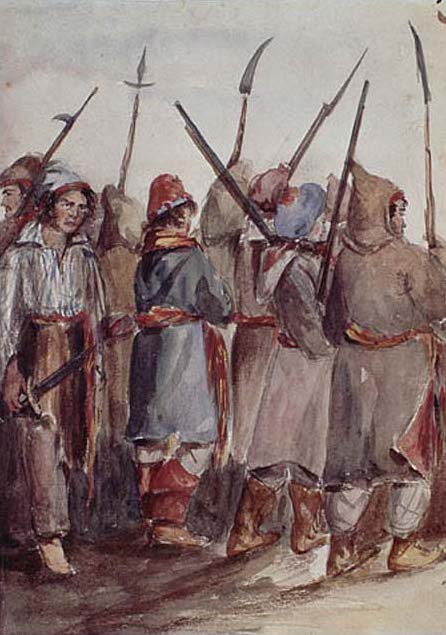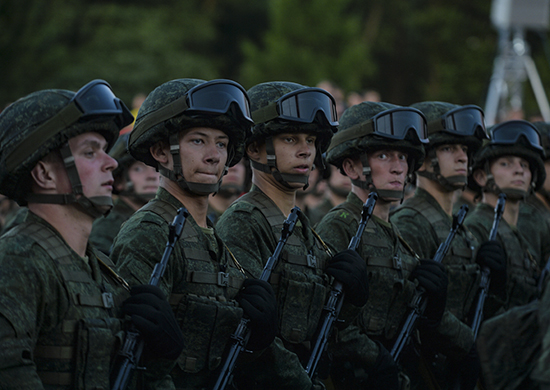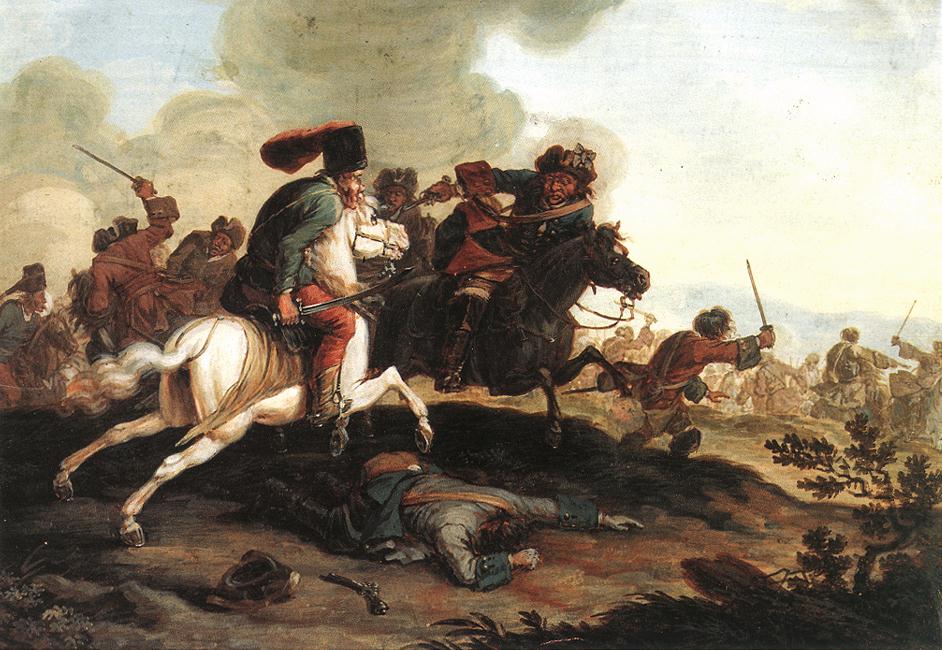|
Landsturm
In German-speaking countries, the term ''Landsturm'' was historically used to refer to militia or military units composed of troops of inferior quality. It is particularly associated with Prussia, Germany, Austria-Hungary, Sweden and the Netherlands. Austria-Hungary The Austro-Hungarian ''Landsturm'' was a reserve force that consisted of men aged 34 to 55. It was intended to provide replacements for the front line units and provide a militia for local defense. It was divided into the Austrian Imperial (Kaiserlich) ''Landsturm'' and the Hungarian Royal ( Königlich) ''Népfelkelés''. During the First World War, the Austrian Landsturm formed 40 regiments totaling 136 battalions in Austria and the Hungarian Landsturm formed 32 regiments totaling 97 battalions. They provided 20 Brigades who took to the field with the rest of the army. Germany Prussia from 1813 In Prussia after the of 21 April 1813 all the male population from ages 15 to 60 who were capable of military ... [...More Info...] [...Related Items...] OR: [Wikipedia] [Google] [Baidu] |
Irregular Military
Irregular military is any non-standard military component that is distinct from a country's national armed forces. Being defined by exclusion, there is significant variance in what comes under the term. It can refer to the type of military organization, or to the type of tactics used. An irregular military organization is one which is not part of the regular army organization. Without standard military unit organization, various more general names are often used; such organizations may be called a ''troop'', ''group'', ''unit'', ''column'', ''band'', or ''force''. Irregulars are soldiers or warriors that are members of these organizations, or are members of special military units that employ irregular military tactics. This also applies to irregular infantry and irregular cavalry units. Irregular warfare is warfare employing the tactics commonly used by irregular military organizations. This involves avoiding large-scale combat, and focusing on small, stealthy, hit-and-run ... [...More Info...] [...Related Items...] OR: [Wikipedia] [Google] [Baidu] |
Austria-Hungary
Austria-Hungary, often referred to as the Austro-Hungarian Empire,, the Dual Monarchy, or Austria, was a constitutional monarchy and great power in Central Europe between 1867 and 1918. It was formed with the Austro-Hungarian Compromise of 1867 in the aftermath of the Austro-Prussian War and was dissolved shortly after its defeat in the First World War. Austria-Hungary was ruled by the House of Habsburg and constituted the last phase in the constitutional evolution of the Habsburg monarchy. It was a multinational state and one of Europe's major powers at the time. Austria-Hungary was geographically the second-largest country in Europe after the Russian Empire, at and the third-most populous (after Russia and the German Empire). The Empire built up the fourth-largest machine building industry in the world, after the United States, Germany and the United Kingdom. Austria-Hungary also became the world's third-largest manufacturer and exporter of electric home appliances, ... [...More Info...] [...Related Items...] OR: [Wikipedia] [Google] [Baidu] |
Military Reserve Force
A military reserve force is a military organization whose members have military and civilian occupations. They are not normally kept under arms, and their main role is to be available when their military requires additional manpower. Reserve forces are generally considered part of a permanent standing body of armed forces, and allow a nation to reduce its peacetime military expenditures and maintain a force prepared for war. In countries with a volunteer military, such as Canada, Spain, the United States and the United Kingdom, reserve forces are civilians who maintain military skills by training periodically (typically one weekend per month). They may do so as individuals or as members of standing reserve regiments—for example, the UK's Army Reserve (United Kingdom), Army Reserve. A militia, home guard, State defense force, state guard or state military may constitute part of a military reserve force, such as the National Guard (United States), United States National Guard a ... [...More Info...] [...Related Items...] OR: [Wikipedia] [Google] [Baidu] |
Landwehr
''Landwehr'', or ''Landeswehr'', is a German language term used in referring to certain national army, armies, or militias found in nineteenth- and early twentieth-century Europe. In different context it refers to large-scale, low-strength fortifications. In German, the word means "defence of the country"; but the term as applied to an insurrectional militia is very ancient, and ''lantveri'' are mentioned in ''Baluzii Capitularia'', as quoted in Henry Hallam, Hallam's ''Middle Ages'', i. 262, 10th edition. The English term "home guard" may possibly derive from an attempt to translate the term ''landwehr'', the earliest unit calling itself "home guard" being formed by German Americans, German immigrants in Missouri in the events leading up to the American Civil War. Austria-Hungary Austrian ''Landwehr'' The Austrian Landwehr was one of three components that made up the Austro-Hungarian Army, ground forces of the Austria-Hungary, Austro-Hungarian Dual Monarchy between 1868 and 1 ... [...More Info...] [...Related Items...] OR: [Wikipedia] [Google] [Baidu] |
Bundesarchiv Bild 105-DOA3029, Deutsch-Ostafrika, Landsturm Angetreten
, type = Archive , seal = , seal_size = , seal_caption = , seal_alt = , logo = Bundesarchiv-Logo.svg , logo_size = , logo_caption = , logo_alt = , image = Bundesarchiv Koblenz.jpg , image_caption = The Federal Archives in Koblenz , image_alt = , formed = , preceding1 = , preceding2 = , dissolved = , superseding1 = , superseding2 = , agency_type = , jurisdiction = , status = Active , headquarters = PotsdamerStraße156075Koblenz , coordinates = , motto = , employees = , budget = million () , chief1_name = Michael Hollmann , chief1_position = President of the Federal Archives , chief2_name = Dr. Andrea Hänger , chief2_position ... [...More Info...] [...Related Items...] OR: [Wikipedia] [Google] [Baidu] |
Latin Language
Latin (, or , ) is a classical language belonging to the Italic languages, Italic branch of the Indo-European languages. Latin was originally a dialect spoken in the lower Tiber area (then known as Latium) around present-day Rome, but through the power of the Roman Republic it became the dominant language in the Italy (geographical region), Italian region and subsequently throughout the Roman Empire. Even after the Fall of the Western Roman Empire, fall of Western Rome, Latin remained the common language of international communication, science, scholarship and academia in Europe until well into the 18th century, when other regional vernaculars (including its own descendants, the Romance languages) supplanted it in common academic and political usage, and it eventually became a dead language in the modern linguistic definition. Latin is a fusional language, highly inflected language, with three distinct grammatical gender, genders (masculine, feminine, and neuter), six or seven ... [...More Info...] [...Related Items...] OR: [Wikipedia] [Google] [Baidu] |
Scythe
A scythe ( ) is an agricultural hand tool for mowing grass or harvesting crops. It is historically used to cut down or reap edible grains, before the process of threshing. The scythe has been largely replaced by horse-drawn and then tractor machinery, but is still used in some areas of Europe and Asia. Reapers are bladed machines that automate the cutting of the scythe, and sometimes subsequent steps in preparing the grain or the straw or hay. The word "scythe" derives from Old English ''siðe''. In Middle English and later, it was usually spelt ''sithe'' or ''sythe''. However, in the 15th century some writers began to use the ''sc-'' spelling as they thought (wrongly) the word was related to the Latin ''scindere'' (meaning "to cut"). Nevertheless, the ''sithe'' spelling lingered and notably appears in Noah Webster's dictionaries. A scythe consists of a shaft about long called a ''snaith'', ''snath'', ''snathe'' or ''sned'', traditionally made of wood but now sometimes me ... [...More Info...] [...Related Items...] OR: [Wikipedia] [Google] [Baidu] |
Shotgun
A shotgun (also known as a scattergun, or historically as a fowling piece) is a long gun, long-barreled firearm designed to shoot a straight-walled cartridge (firearms), cartridge known as a shotshell, which usually discharges numerous small pellets (petrology), pellet-like spherical sub-projectiles called shot (pellet), shot, or sometimes a single solid projectile called a shotgun slug, slug. Shotguns are most commonly smoothbore firearms, meaning that their gun barrels have no rifling on the inner wall, but rifled barrels for shooting slugs (slug barrels) are also available. Shotguns come in a wide variety of calibers and Gauge (firearms), gauges ranging from 5.5 mm (.22 inch) to up to , though the 12-gauge (18.53 mm or 0.729 in) and 20-gauge (15.63 mm or 0.615 in) bores are by far the most common. Almost all are breechloading, and can be single-barreled, double barreled shotgun, double-barreled, or in the form of a combination gun. Like rifles, ... [...More Info...] [...Related Items...] OR: [Wikipedia] [Google] [Baidu] |
Jus In Bello
The law of war is the component of international law that regulates the conditions for initiating war (''jus ad bellum'') and the conduct of warring parties (''jus in bello''). Laws of war define sovereignty and nationhood, states and territories, occupation, and other critical terms of law. Among other issues, modern laws of war address the declarations of war, acceptance of surrender and the treatment of prisoners of war; military necessity, along with ''distinction'' and ''proportionality''; and the prohibition of certain weapons that may cause unnecessary suffering. The ''law of war'' is considered distinct from other bodies of law—such as the domestic law of a particular belligerent to a conflict—which may provide additional legal limits to the conduct or justification of war. Early sources and history The first traces of a law of war come from the Babylonians. It is the Code of Hammurabi, king of Babylon, which, 2000 B.C., explains its laws imposing a code of con ... [...More Info...] [...Related Items...] OR: [Wikipedia] [Google] [Baidu] |
Insurgency
An insurgency is a violent, armed rebellion against authority waged by small, lightly armed bands who practice guerrilla warfare from primarily rural base areas. The key descriptive feature of insurgency is its asymmetric nature: small irregular forces face a large, well-equipped, regular military force state adversary. Due to this asymmetry, insurgents avoid large-scale direct battles, opting instead to blend in with the civilian population (mainly in the countryside) where they gradually expand territorial control and military forces. Insurgency frequently hinges on control of and collaboration with local populations. An insurgency can be fought via counter-insurgency warfare, as well as other political, economic and social actions of various kinds. Due to the blending of insurgents with the civilian population, insurgencies tend to involve considerable violence against civilians (by the state and the insurgents). State attempts to quell insurgencies frequently lead to the i ... [...More Info...] [...Related Items...] OR: [Wikipedia] [Google] [Baidu] |
Civilian
Civilians under international humanitarian law are "persons who are not members of the armed forces" and they are not "combatants if they carry arms openly and respect the laws and customs of war". It is slightly different from a non-combatant, because some non-combatants are not civilians (for example, military chaplains who are attached to the belligerent party or military personnel who are serving with a neutral country). Civilians in the territories of a party to an armed conflict are entitled to certain privileges under the customary laws of war and international treaties such as the Fourth Geneva Convention. The privileges that they enjoy under international law depends on whether the conflict is an internal one (a civil war) or an international one. In some nations, uniformed members of civilian police or fire departments colloquially refer to members of the public as civilians. Etymology The word "civilian" goes back to the late 14th century and is from Old French '' ... [...More Info...] [...Related Items...] OR: [Wikipedia] [Google] [Baidu] |
Peninsula War
The Peninsular War (1807–1814) was the military conflict fought in the Iberian Peninsula by Spain, Portugal, and the United Kingdom against the invading and occupying forces of the First French Empire during the Napoleonic Wars. In Spain, it is considered to overlap with the Spanish War of Independence. The war started when the French and Spanish armies invaded and occupied Portugal in 1807 by transiting through Spain, and it escalated in 1808 after Napoleonic France occupied Spain, which had been its ally. Napoleon Bonaparte forced the abdications of Ferdinand VII and his father Charles IV and then installed his brother Joseph Bonaparte on the Spanish throne and promulgated the Bayonne Constitution. Most Spaniards rejected French rule and fought a bloody war to oust them. The war on the peninsula lasted until the Sixth Coalition defeated Napoleon in 1814, and is regarded as one of the first wars of national liberation. It is also significant for the emergence of large- ... [...More Info...] [...Related Items...] OR: [Wikipedia] [Google] [Baidu] |








